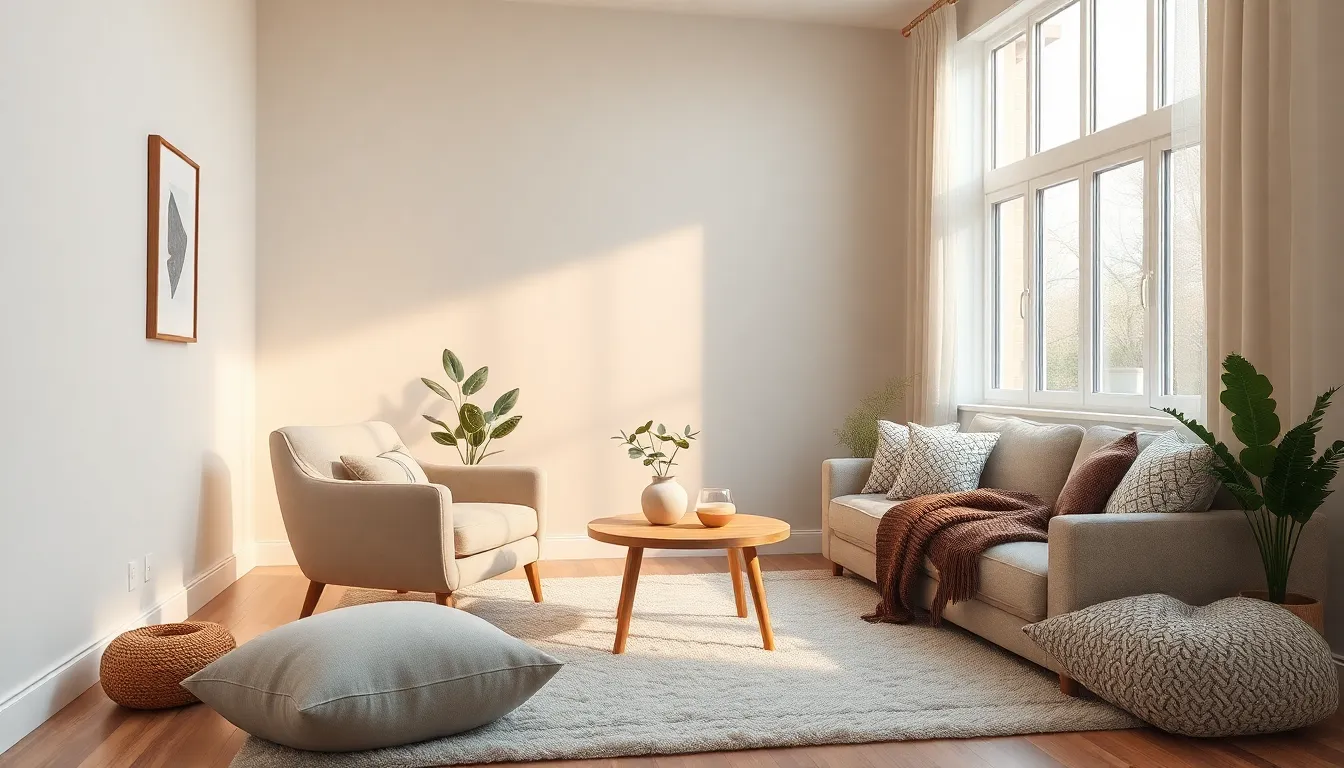In a world buzzing with chaos, finding a slice of serenity at home is like discovering a unicorn. Relaxing space planning isn’t just about throwing a bean bag in the corner; it’s a strategic art form that transforms everyday spaces into havens of tranquility. Imagine walking into a room that whispers “chill” rather than “chaos.”
With the right layout, colors, and furnishings, anyone can create a sanctuary that soothes the soul and sparks joy. It’s time to ditch the clutter and embrace a design philosophy that prioritizes peace. After all, who wouldn’t want a space that feels like a warm hug after a long day? Let’s dive into the essentials of relaxing space planning and turn that dream of a calm retreat into reality.
Table of Contents
ToggleUnderstanding Relaxing Space Planning
Relaxing space planning plays a crucial role in creating an inviting home environment. Each element contributes to overall tranquility and comfort.
Importance of Relaxing Spaces
Relaxing spaces promote mental well-being and reduce stress. Such spaces provide refuge from daily chaos, allowing individuals to recharge. Comfort in a home encourages relaxation and enhances productivity. Research shows that well-designed environments can improve mood and foster creativity. The arrangement of furniture, color choices, and decor significantly influences feelings of calmness. A soothing atmosphere leads to greater satisfaction and happiness in daily life.
Key Principles of Relaxing Space Planning
Prioritizing simplicity enhances the calming effect of a space. Select a neutral color palette to create a serene backdrop. Incorporating natural light contributes to a fresh and open feel. Furniture placement should facilitate easy movement and accessibility. Using soft textures adds warmth and invites relaxation. Mindful decor choices promote a sense of belonging and comfort. Eliminating clutter ensures visual tranquility and supports mental clarity. Each decision in space planning should reflect the goal of cultivating a peaceful retreat.
Elements of a Relaxing Space

Creating a relaxing space revolves around essential elements like color schemes and furniture selection. Each aspect contributes to overall tranquility.
Color Schemes
A neutral color palette promotes serenity. Soft tones such as beige, light gray, and pastels create a calming backdrop. Introducing subtle variations through accent colors can add depth without overwhelming the space. Warm colors invite comfort, while cool tones encourage relaxation. Using these shades in wall paint, textiles, and decor helps maintain harmony. Natural color inspiration can stem from the outdoors, making it easier to connect with nature indoors. Overall, selecting colors that evoke feelings of peace enhances the environment.
Furniture Selection
Furniture choice significantly impacts comfort and functionality. Opting for pieces with soft edges promotes safety and relaxation. Prioritizing ergonomic designs ensures that seating provides proper support. Sofas and chairs should invite lounging, while tables should encourage ease of movement. Incorporating multifunctional furniture saves space and reduces clutter. Mesh storage options under beds and ottomans can easily hide items and maintain order. Selecting materials like cotton and linen enhances tactile comfort. Each choice should align with the goal of creating a soothing oasis that fosters well-being.
Creating a Relaxing Atmosphere
Creating a relaxing atmosphere hinges on careful selection of elements that complement each other. Two vital components are lighting and textures.
Lighting Options
Soft lighting creates a calming ambiance in any space. Incorporating various sources, like floor lamps, table lamps, and wall sconces, allows for versatility in illumination. Warm LED bulbs enhance tranquility, while dimmers enable control over brightness levels. Natural light also plays an essential role; it boosts mood and connects individuals to the outdoors. Using sheer curtains allows sunlight to filter through gently. Highlighting particular areas, such as reading nooks, with adjustable task lighting can further enhance relaxation.
Textures and Materials
Textures contribute significantly to a soothing environment. Soft fabrics, like cotton and linen, provide comfort and warmth. Layering different materials, such as plush rugs and chunky knits, adds depth and invites touch. Natural elements, including wood and stone, bring an organic feel that fosters tranquility. Incorporating houseplants introduces both greenery and beneficial air quality. Each texture choice should promote comfort, ensuring that surfaces invite relaxation. Prioritizing tactile experiences creates a sense of belonging, essential for a calming retreat.
Tips for Effective Relaxing Space Planning
Effective relaxing space planning relies on thoughtful arrangements and personalized touches. Attention to detail enhances tranquility and overall comfort.
Layout Considerations
Strategic furniture placement fosters easy movement and promotes relaxation. Open pathways encourage flow, preventing clutter from disrupting peace. Zone areas dedicated to reading or unwinding elevate the calming atmosphere. Use furniture with soft edges to create inviting social spaces. Opt for larger pieces in the center, with smaller items surrounding them, to maintain balance. Thoughtful layout decisions highlight natural focal points, like windows or artwork, drawing attention to elements that enhance serenity.
Personalization Strategies
Incorporating personal style into a relaxing space creates a sense of belonging. Select decor that resonates with individual tastes, such as art or sentimental items. Choose colors reflecting personality to evoke positive emotions. Soft textiles and layered materials can enhance comfort while showcasing unique preferences. Integrate natural elements, like plants or stones, to reinforce the connection to the environment. Mindful design choices should cater to individual comfort, ensuring the space feels inviting and true to oneself.
Creating a relaxing space is essential for promoting mental well-being and reducing stress. Thoughtful space planning can transform ordinary areas into soothing sanctuaries. By prioritizing simplicity and incorporating natural elements, anyone can enhance their living environment.
The right color palette and furniture choices play a key role in fostering tranquility. Soft lighting and inviting textures further contribute to a calming atmosphere. Ultimately, each design decision should reflect the desire for peace and comfort. Embracing these principles allows individuals to cultivate a personal oasis where they can recharge and thrive.








